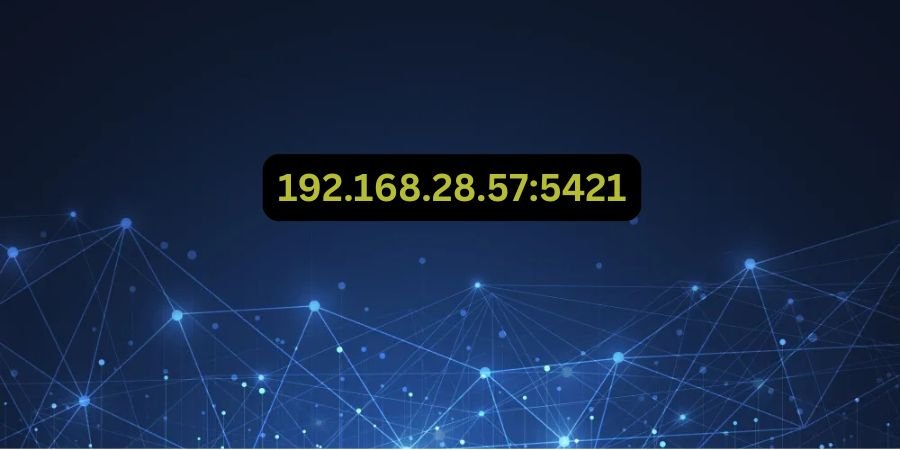192.168.28.57:5421: A Guide to Understanding Private IP and Port Configurations
192.168.28.57:5421 is an example of a private IP address paired with a port number, commonly used in local networks to establish connections between devices. The IP address, 192.168.28.57, identifies a specific device within the network, while the port number 5421 helps direct the communication to a particular service or application running on that device. This combination allows for secure and efficient data transfer within a network, without the need for direct internet exposure. Understanding how 192.168.28.57:5421 works is key to managing network traffic and ensuring that devices communicate smoothly within a private network.
What is 192.168.28.57:5421?
An IP address, like 192.168.28.57:5421, is a unique identifier assigned to devices within a network, allowing them to communicate with each other. Think of it as a digital address that directs data to the right location, much like a street address for mail. Every connected device computers, smartphones, even smart home gadgets receives an IP to facilitate these interactions. In particular, 192.168.28.57 is an example of a private IP address, used primarily in local networks, while the port number 5421 specifies a particular service on that device, making the IP combination crucial for efficient, targeted data transfer.
The Significance of Private IPs Like 192.168.28.57
The IP address 192.168.28.57 falls within the 192.168.x.x range, which is designated as a private IP range. These IPs are commonly used within local networks, such as in homes, offices, or other closed network environments. Devices with private IPs can communicate freely within their own network, but they do not directly interact with devices on the broader internet without special configurations. The private IP ranges were set aside by the Internet Assigned Numbers Authority (IANA) to preserve addresses for internal networks without conflicting with globally routable IPs.
Why Are Private IP Addresses Used?
Private IP addresses are essential for local area networks (LANs). They provide several benefits, including added security and efficient IP management. Since devices with private IPs aren’t exposed to the internet directly, they are safer from external cyber threats. Additionally, using private IPs 192.168.28.57:5421 allows an organization or household to use a limited number of IP addresses, as they do not need unique addresses for each device within their network.
Understanding Ports in Networking
Ports are integral to how devices on a network communicate with specific applications or services. Just as IP addresses help identify a device, ports help identify specific processes or services within that device. For instance, web traffic usually passes through port 80 (HTTP) or port 443 (HTTPS) by default, while email services may use ports like 25, 110, or 587. Ports are represented by numbers ranging from 0 to 65535, and each number corresponds to a different type of service or protocol.
The Purpose of Port 5421
In the example 192.168.28.57:5421, the “5421” represents the port. While certain port numbers are reserved for specific services (e.g., port 80 for web traffic), other ports, like 5421, are often available for various custom uses. Administrators may configure port 5421 for a particular service within a private network, such as file sharing or internal applications. The flexibility of port assignments allows networks to adapt to a wide range of needs, from streaming media to accessing remote desktops.
How IP Combinations Facilitate Communication
An IP combination, like 192.168.28.57:5421, allows data to be directed to the correct device and service within a network. This pairing ensures that the information reaches its destination accurately. Imagine a large office with many departments. The IP address could represent the office building, while the port represents a specific department within it. In networking, this system allows data to navigate smoothly to its endpoint, ensuring efficient and reliable communication.
Setting Up a Local Network with Private IPs
Setting up a local network with private IP addresses, such as 192.168.28.57, is common in households and small businesses. Routers within the network assign private IP addresses to each connected device, creating a closed network where devices can share data seamlessly. This setup typically involves configuring the router to use the 192.168.x.x range and assigning individual IP addresses to devices through the Dynamic Host Configuration Protocol (DHCP).
Connecting to 192.168.28.57:5421 on a Local Network
To connect to 192.168.28.57:5421 within a network, you would generally need to know both the IP and port numbers. This is often done through various software tools or network settings, depending on the service. For instance, connecting to a remote desktop would require an application that allows access to IP combinations. Entering 192.168.28.57:5421 in such software directs the connection to the correct service within that local IP.
Security Concerns with IP Access
While using a private IP like 192.168.28.57 is secure within its network, opening ports such as 5421 can present security risks if not managed carefully. Each open port can serve as a potential entry point for unauthorized access. Therefore, many networks use firewalls to restrict access to certain IP combinations, allowing only trusted devices or users to connect. Configuring a firewall to block or allow specific ports is essential in safeguarding against cyber threats.
The Role of NAT in Managing Private IP Addresses
Network Address Translation (NAT) is a process where routers modify IP address information in packets. NAT is critical when devices with private IPs, like 192.168.28.57, need to access resources outside the network. By translating private IPs into a single public IP, NAT enables multiple devices to share a single public IP address. This makes NAT an essential tool for conserving IP address space and enhancing network security.
Testing IP and Port Connectivity
To ensure that an IP combination like 192.168.28.57:5421 is accessible, testing tools such as ping, tracert, and telnet can be used. These tools help determine whether the device with the specified IP address is reachable and if the port is open. Troubleshooting connectivity issues can prevent disruptions in network services and optimize network efficiency.
Configuring Firewalls for Port Security
Firewalls are essential in controlling access to networks and devices. To allow communication to 192.168.28.57:5421, you may need to configure the firewall to permit traffic on port 5421. This configuration ensures that only authorized devices and services can access specific network areas. In addition to enabling secure connections, firewalls provide a safeguard against malicious activity by monitoring and filtering network traffic.
Benefits and Limitations of Private IPs Like 192.168.28.57
Private IP addresses offer numerous benefits, including security and efficient network management. However, they also come with limitations. Devices with private IPs cannot communicate directly with the internet without NAT or a similar method. This can restrict certain types of connections and may require additional configurations for external access.
FAQs about 192.168.28.57:5421
What is 192.168.28.57:5421 used for?
This IP combination refers to a specific device (192.168.28.57) and service or application (5421) within a private network.
Why can’t I access 192.168.28.57 from the internet?
192.168.28.57 is a private IP address, so it is only accessible within a local network unless configured otherwise.
What does port 5421 indicate?
Port 5421 is an arbitrary port that may be configured for any service within a network. It could be set up for specific applications or custom network services.
Is using private IP addresses like 192.168.28.57 secure?
Yes, private IPs add a layer of security by keeping devices within a network isolated from direct internet exposure.
How do I test connectivity to 192.168.28.57:5421?
You can test connectivity using tools like ping or telnet to ensure the IP address and port are accessible within your network.
Conclusion
Understanding the combination of a private IP address and port, such as 192.168.28.57:5421, is crucial for anyone involved in network management or digital security. These elements enable devices to communicate securely and efficiently within a network. By leveraging private IP addresses, ports, and tools like NAT and firewalls, users can create a robust and secure network environment. Whether for home, office, or enterprise networks, the effective use of IPs and ports enhances both connectivity and safety in today’s digital world.
Share this content:














Post Comment